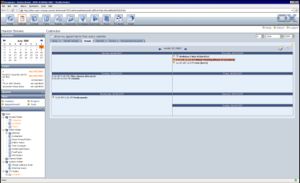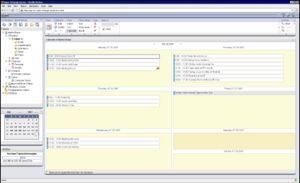Versioning and Numbering: Difference between revisions
| Line 5: | Line 5: | ||
=== Generations and Codenames === | === Generations and Codenames === | ||
The Open-Xchange Project and Open-Xchange Inc. currently release two different generations of the Open-Xchange Collaboration Suite | The Open-Xchange Project and Open-Xchange Inc. currently release two different generations of the Open-Xchange Collaboration Suite. | ||
Open-Xchange '' | Open-Xchange Server 5 has been released as a community edition that uses the version namespace 0.8.x which is published in regular cycles as a source-only release. It is the groundwork for the commercial ''Open-Xchange Server 5'' product line. Commercial products use build numbers starting at "5000". Outlook connectors for this version use build numbers starting at 4.0. | ||
Open-Xchange Server 6 has been initial published in February 2007 and its sourcecode is distributed via a daily synchronized CVS repository and precompiled packages to the Open-Source community. It is the groundwork for the commercial products ''Open-Xchange Express Edition'', ''Open-Xchange Hosting Edition'' and ''Open-Xchange Server Edition''. Build numbers for all releases are starting at "6000". Outlook connectors for this version use build numbers starting at 6.0. | |||
Those two software generations differ extremely from each other, they use different backends, different APIs, different code and different user interfaces. They have in common that they are maintained by Open-Xchange Inc. and are at steady improvement by Open-Xchange Inc. and the Open-Source community. Those two generations as well as the Outlook connectors are not compatible to each other as of different backend technology and data formats. | Those two software generations differ extremely from each other, they use different backends, different APIs, different code and different user interfaces. They have in common that they are maintained by Open-Xchange Inc. and are at steady improvement by Open-Xchange Inc. and the Open-Source community. Those two generations as well as the Outlook connectors are not compatible to each other as of different backend technology and data formats. | ||
Revision as of 20:44, 14 July 2008
Versioning and Numbering of Open-Xchange Products
Note: This list is under heavy modification and not yet recommended to use as a reference. This wiki page does not want to compare the different versions and generations of the Open-Xchange groupware. The target is to have a objective overview about the existing versions and what all those abbreviation mean.
General Declaration
Generations and Codenames
The Open-Xchange Project and Open-Xchange Inc. currently release two different generations of the Open-Xchange Collaboration Suite.
Open-Xchange Server 5 has been released as a community edition that uses the version namespace 0.8.x which is published in regular cycles as a source-only release. It is the groundwork for the commercial Open-Xchange Server 5 product line. Commercial products use build numbers starting at "5000". Outlook connectors for this version use build numbers starting at 4.0.
Open-Xchange Server 6 has been initial published in February 2007 and its sourcecode is distributed via a daily synchronized CVS repository and precompiled packages to the Open-Source community. It is the groundwork for the commercial products Open-Xchange Express Edition, Open-Xchange Hosting Edition and Open-Xchange Server Edition. Build numbers for all releases are starting at "6000". Outlook connectors for this version use build numbers starting at 6.0.
Those two software generations differ extremely from each other, they use different backends, different APIs, different code and different user interfaces. They have in common that they are maintained by Open-Xchange Inc. and are at steady improvement by Open-Xchange Inc. and the Open-Source community. Those two generations as well as the Outlook connectors are not compatible to each other as of different backend technology and data formats.
Open-Xchange Server 6 is the successor of Open-Xchange Server 5.
Commercial and Community Releases
TODO
Abbreviations
| Abbreviation | Meaning |
|---|---|
| GA | General Availability - The date the software became available |
| SP | Service Pack - Major feature updates |
| BFR / Update | Bug Fix Release - Bug Fixes, Minor feature corrections |
Open-Xchange Server 5 (Codename: Hymalia)
Abstract
TODO
Screenshot
Editions
| Abbreviation | Description | Target usage |
|---|---|---|
| OX 0.8.x | Community Edition | |
| OX5 SBS | OX5 Small Business Suite | For small companies with a maximum of 25 users. |
| OX5 ASE | OX5 Advanced Server Edition | For larger organizations with more than 25 users. |
Releases
| GA | Build | Release Name |
|---|---|---|
| 2005-04-22 | - | Open-Xchange Server 0.8.0 (Community) |
| 2006-02-16 | 5060 | Open-Xchange Server 5 SP1 |
| 2006-04-25 | - | Open-Xchange Server 0.8.2 (Community) |
| 2006-10-20 | 5083 | Open-Xchange Server 5 BFR 2006-10 |
| 2006-12-06 | 5318 | Open-Xchange Server 5 SP2 |
| 2007-02-26 | 5333 | Open-Xchange Server 5 BFR 2007-02 |
| 2007-03-13 | - | Open-Xchange Server 0.8.6 (Community) |
| 2007-06-01 | 5607 | Open-Xchange Server 5 SP3 |
| 2007-10-19 | - | Open-Xchange Server 0.8.7 (Community) |
Resources
TODO
Open-Xchange Server 6 (Codename: Hyperion)
Abstract
One of the most remarkable visual differences between Hymalia and Hyperion is the user interface which has been re-developed from scratch with a attention to usability, performance and design. The GUI does not render on the server any longer but it is built upon HTML, CSS and ECMAScript (Javascript) that renders every UI element dynamically at the users browser and communicates with the server using the JSON data-interchange format. This technology is better known as AJAX.
As well as the user interface, all server components have been re-engineered and simplified. Instead of using Apache Tomcat as servlet engine, a custom AJP13 implementation for the server frontend has been designed. All kinds of data is stored to a MySQL database by default instead of PostgreSQL, LDAP is also no longer a core component.Binary data such as attachments or infostore entries are stored to a common filestorage with references at the database for better indexing and performance.
Compared to Hymalia, Hyperion is capable to serve a unlimited amount of users as the backends can be easily clustered using the Java Caching System (JCS). Because all user interface actions are handled by the users browser, the server only deals with raw user data instead of HTML generation which leads to a massive boost of concurrent users and response times as well as bandwidth saving. This is one factor why Open-Xchange Server 6 is used by Software-as-a-Service (SaaS) providers that offer hosted solutions which are accessed via the internet.
Open-Xchange Server 6 offers a standardized HTTP_API to connect external clients which use the groupware capabilites of the Open-Xchange Server. Another common interface to the server is the Oxwebdavapi which provides WebDAV/XML access. This interface is used by the OXtender for Microsoft Outlook for example.
Access for external storage clients like Novell Netdrive, Konqueror or the Microsoft Windows Explorer to use the Infostore module as a virtual hard-drive is realized via WebDAV. This feature is very useful for desktop integration as it is platform independent and all groupware permissions is also maintained.
Server configuration and administration is possible by using the Java Remote Method Invocation (RMI) interface. This technology can be accessed directly or via a set of Command Line Tools which are wrappers to the RMI interface. Server Monitoring is realized by using Java Management Extensions (JMX).
Screenshot
Editions
| Abbreviation | Description | Target usage |
|---|---|---|
| OX CE | Open-Xchange Community Edition | Development, Education, Evaluation, Always the latest code |
| OX HE | Open-Xchange Hosting Edition | Large scale deployment and integration in hosting environments |
| OX EE | Open-Xchange Express Edition | Out-Of-The-Box Groupware experience |
Releases
| GA | Build | Release Name |
|---|---|---|
| 2007-02-27 | 6048 | Open-Xchange Hosting Edition |
| 2007-02-27 | 6048 | 1&1 MailXchange Initial Release |
| 2007-03-12 | - | Open-Xchange Community Edition |
| 2007-06-04 | 6115 | 1&1 MailXchange SP1 |
| 2007-07-16 | 6213 | Open-Xchange Express Edition Initial Release |
| 2007-07-19 | 6213 | 1&1 MailXchange SP2 |
| 2007-08-29 | 6214 | Open-Xchange Express Edition Update 1 |
| 2007-09-20 | 6302 | Open-Xchange Hosting Edition SP3 |
| 2007-09-29 | 6306 | Open-Xchange Express Edition Update 2 |
| 2007-11-13 | 6312 | Open-Xchange Hosting Edition SP3 Update 1 |
Resources
TODO

